
~~~~~~~~~~~~~~~~~~~~~~~~~~~~~~~~~~~~~~~~~~~~~~~~~~~~~~~~
TBPNews #153- August 9 2012
~~~~~~~~~~~~~~~~~~~~~~~~~~~~~~~~~~~~~~~~~~~~~~~~~~~~~~~~
>>>> Tunnel Boat Performance News
>>>>>> (over 5000
members!) ![]()
![]()
========================================================
See all TBPNews archives at: TBPNews
In this issue:
1)
Selio Wins In A Stunner On Day Two In Kiev
2) Jim Drake, Co-Inventor of the "Windsurfer" Dies at 83
3) David, Oberto win Seafair hydro race for third straight year
5) FEATURE: "How Does Deadrise Affect a Vee-Pad?"
6) 13th Edition "Secrets of Tunnel Boat Design" book
8) Jimboat's NEW Feature Articles & Reports
******************** TBPNews
***********************
Check out review
of Jimboat's 13th Ed. "Secrets of Tunnel Boat Design" book in the last HotBoat
magazine printed!
1) Selio Wins In A Stunner On Day Two In Kiev
 KIEV, Ukraine - In what took two days to run the 2nd Annual Grand Prix of Ukraine the third event on the UIM F1 H2O World Championship series turned out to be worth the wait.
KIEV, Ukraine - In what took two days to run the 2nd Annual Grand Prix of Ukraine the third event on the UIM F1 H2O World Championship series turned out to be worth the wait.
The drama began when American driver Shaun Torrente of the Qatar Team out maneuvered Finland's Sami Selio early in the race to grab the lead on the first re-start. Torrente controlled the race until another yellow flag came out and with less than six laps to the finish when Selio charged by Torrente when his engine broke sending Selio to win for the 10th time in his career and the first since December of 2010.
The Mad Croc F1 Team driver has now proven he is totally recovered and is back on track to once again to challenge for a title by winning in front of thousands of spectators on the edge of the Kiev Sea. His victory gives him 41 points on the season moving him from fourth to second in the drivers championship. Coming home in second after starting down in 10th position was Ahmed Al Hameli of Team Abu Dhabi who with his 15 points has increased his championship points lead to nine earning now 50 thus far as he reached the podium for his seventh straight race for last years winning driver. Taking third was Qatar Team driver and defending World Champion Alex Carella of Italy who had a steady drive finishing 4.36 seconds back and more importantly picking up 12 points that are crucial for his dreams of making it back to back titles by the end of the 2012 campaign.
Philippe Chiappe of the CTIC China Team fought violently in the final few tours in hopes of making it three straight podium performances this season only to be turned back by Carella. The driver from Rouen was in a scrap with Italian Francesco Cantando of the Singha Team for most of the 37 laps with Franz finishing with a fifth place position at the end of the day.
The UIM F1 H2O World Championship now heads for China on October 1 where the series returns to lovely Liuzhou for the fourth round of the 2012 campaign.
Read more here: f1h2o.com
******************* TBPNews ******************* [return to top]
2) Jim Drake, Co-Inventor of the "Windsurfer" Dies at 83
 Jim Drake, the co-inventor of the "Windsurfer" and father of modern windsurfing, has passed away at the age of 83. The North American aeronautics engineer improved the early design by Peter Chilvers and Newman Darby.
Jim Drake, the co-inventor of the "Windsurfer" and father of modern windsurfing, has passed away at the age of 83. The North American aeronautics engineer improved the early design by Peter Chilvers and Newman Darby.
In the 1970s, Jim Drake and his partner Hoyle Schweitzer submitted the patent for their "Windsurfer" design, based on the Newman Darby's techniques. They credited him for their version of the sailboard. Jim Drake learned from Darby's developments and upgraded the board and rig layout, as well as the universal joint which stands modern and used all over the world.
Drake was born in California in 1929. Thirty five years later, he was trying to develop a kite powered surfboard that would allow him to sail down the Potomac River. Later, he meets Hoyle Schweitzer - a keen surfer - and they decide to build and test their first models in Marina del Rey. After falling several times, he knew he had to introduce the uphaul. Watch an historical video documenting these water tests, here. By 1967, they had already named it "Baja Board" but, interestingly, it was a Public Relations professional who found the perfect word for their sailing concept. "I have the perfect name for it! The Windsurfer!", the PR yelled. Name accepted.
In 1973, Jim Drake sells his half of the patent to Windsurfing International, owned by Hoyle Schweitzer, for $36,000. The windsurfing business grows and is very popular in Europe during the 1980s. The US courts decide that the "Windsurfer" is strongly inspired in Peter Chilvers and Newman Darby's prototypes and Schweitzer closes his Windsurfing International. Jim Drake's contribution to the sport of windsurfing is decisive.
Check out more at surfertoday.com
******************* TBPNews ******************* [return to top]
3) David, Oberto win Seafair hydro race for third straight year
 SEATTLE - With the inside lane -- and the shortest route around the course -- in hand, David cruised to the victory on a hot, pristine day at Lake Washington to capture the Seafair trophy for the U-6 Oh Boy! Oberto for the third straight year.
SEATTLE - With the inside lane -- and the shortest route around the course -- in hand, David cruised to the victory on a hot, pristine day at Lake Washington to capture the Seafair trophy for the U-6 Oh Boy! Oberto for the third straight year.
It was also the fourth Seafair win for Oberto since 2007, when it won its first race on its home course. Victories in Seattle are suddenly becoming old hat for 85-year-old boat sponsor Art Oberto. "Now the problem is he expects it every year," said David, laughing and looking at Oberto surrounded by a happy pit celebration.
Finishing second was Jimmy Shane in the U-5 Graham Trucking. Dave Villwock in the U-96 Spirit of Qatar finished behind J. Michael Kelly in fourth, but was bumped up to third when Kelly was penalized a lap.
Shane and Villwock were among four boats that decided to slow down and essentially park just shy of the one-minute buoy, hoping to steal inside lanes. David took a different strategy, deciding to circle around them a few times and hit the one-minute buoy at full speed, then get far enough ahead that he would have the five-roostertail cushion needed to grab the inside lane. David tried the same move last week at the Columbia Cup in the Tri-Cities, but got there too early and was assessed a penalty, allowing Shane to win. David said he had worked out the calculations he would need to get that perfect timing during a few sessions in his trailer.
The victory allowed David and the Oberto to surpass Villwock and the Qatar -- which had a 190-point lead heading into the weekend -- in the points standings. The Oberto leaves Seattle with 5,817 points to the Qatar's 5,620 with races remaining in San Diego in September and Doha, Qatar in January. The win also continued what has been a late-career revival for David, who began racing unlimited in 1988 but had only four victories before 2005. He now has 15.
For more information, go to: tri-cityherald.com
******************* TBPNews ******************* [return to top]
4) Great Powerboat Videos
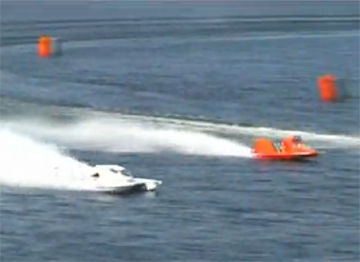 Check
out these great videos....
Check
out these great videos....
.........Seven Marine's 557-hp Outboard
.........Bill Muncey Wide World Championship of Drivers - SE Tunnel Boat Races
.........F1 Water Ski Racing
............and more
******************* TBPNews
*******************
[return to top]
5) FEATURE: "How Does Deadrise Affect a Vee-Pad?"
 We often have requests to explain factors that influence the working of performance powerboat hulls. We recently had a question about the deadrise of the Pad on a vee-pad hull. Should the pad be flat? Or should it be slightly veed? Or more-veed?
We often have requests to explain factors that influence the working of performance powerboat hulls. We recently had a question about the deadrise of the Pad on a vee-pad hull. Should the pad be flat? Or should it be slightly veed? Or more-veed?
Flat pad or veed pad?
The amount of deadrise in a planing pad is a tricky design decision. What is good for one boat might not be good for another.
Pads are usually part of a vee hull design as a method of increasing total hydrodynamic lift capability and increasing top speed. There are dozens of design and setup factors that impact performance, and most of them also influence each other. This makes prediction of performance a complex business. The good news is that most of these factors can be calculated at the design stage, and so we can design a boat or its modifications for the intended performance. [We use VBDP and TBDP software to do the hard work for us]
Deadrise affects hydrodynamic lift efficiency
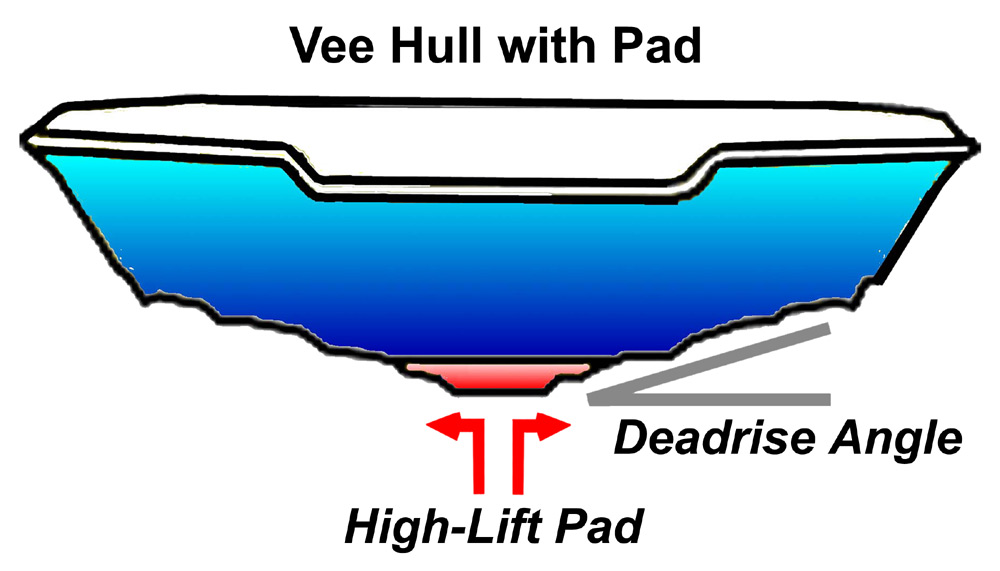 A flat pad (zero deadrise) really is the most efficient lifting surface. But it's not a simple issue to consider. The Lift of a planing pad is dependent on many factors....angle of attack, width/length ratio (called Aspect Ratio), velocity, deadrise, pad depth (height), also the vee hull surfaces design and hull aerodynamics too.
A flat pad (zero deadrise) really is the most efficient lifting surface. But it's not a simple issue to consider. The Lift of a planing pad is dependent on many factors....angle of attack, width/length ratio (called Aspect Ratio), velocity, deadrise, pad depth (height), also the vee hull surfaces design and hull aerodynamics too.
Let’s use an example. For a typical angle of attack for a boat at a particular velocity, the Lift is more efficient (better) with a pad of deadrise=zero, than it is if the pad has a greater deadrise (like, for example, 16 degrees). This is because the pad generates less efficient lift with greater deadrise, which is a bad thing. The drag, however, is also less with the greater deadrise pad, which is a good thing. BUT - the lift reduction is more dramatic (with increasing deadrise) than is the drag reduction (lift reduces more than the drag does). So the overall effect is less lift efficiency with pads of higher deadrise angles.
The measure of this overall "efficiency" is called L/D ratio. The higher the L/D ratio, the more efficient is the design.
 For example, the L/D for a zero deadrise pad is 2.4 times more (better) than the same sized pad with a 16 degree deadrise. The drag of the zero deadrise pad is slightly more ( 30%) than the16 degree pad, but the lift is over 300% better than the 16 degree pad. So the zero degree pad has more drag, but it has MUCH more Lift - and so overall it is operating at much higher efficiency (2.4 times) than the 16 degree pad.
For example, the L/D for a zero deadrise pad is 2.4 times more (better) than the same sized pad with a 16 degree deadrise. The drag of the zero deadrise pad is slightly more ( 30%) than the16 degree pad, but the lift is over 300% better than the 16 degree pad. So the zero degree pad has more drag, but it has MUCH more Lift - and so overall it is operating at much higher efficiency (2.4 times) than the 16 degree pad.
Aspect Ratio (width/length) affects Lift/Drag efficiency too!
There is another reason too! Since there is less lift with the higher deadrise pad, the hull needs more wetted surface area to support the weight of the boat. So more of the pad length must be wetted. This means a lower Aspect Ratio (Width/Length) - which reduces the Lift/Drag efficiency even more.
So for the example of the 16 degree deadrise pad, the longer wetted surface (lower AR) reduces it's L/D even further - and so after accounting for the change in wetted surface and AR, the "zero deadrise" pad is actually 2.6 times more efficient (L/D) than the same sized pad with a 16 degree deadrise.
It is always a compromise
Of course, all boat design is a compromise. A higher deadrise can offer a better water entry, and a softer ride, and better tracking. And a higher deadrise is less susceptible to Porpoising. Also remember, the angle of attack (trim), velocity and aerodynamic effects can also change the whole picture. So the decision isn't always obvious. But it is certainly worth considering when you're designing your hull with a planing pad.
[See also, Jimboat's article on Vee Pad Design - 'The Bottom Line'-"Why does a Pad make a Vee Hull faster?"]
See more Performance Articles at: aeromarineresearch.com/articles.html
Read more about Vee Hull & Tunnel Boat design and setup in the world acclaimed "Secrets of Tunnel Boat Design" book
[Note: Do you have any of your own questions on performance hull design? Send your question or story to Jimboat@aeromarineresearch.com ]
******************* TBPNews ******************* [return to top]
6) NEW! 13th Edition "Secrets of Tunnel Boat Design" book
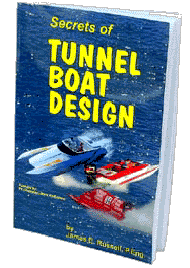 13th Edition "Secrets of Tunnel Boat Design" (ISBN# 1-894933-30-3) - By well-known powerboat design author and race-driver, Jim Russell.
13th Edition "Secrets of Tunnel Boat Design" (ISBN# 1-894933-30-3) - By well-known powerboat design author and race-driver, Jim Russell.
Learn how to design and setup your own tunnel boat, power cat, or modified vee hull for all Recreation, Performance Family hulls, UIM & APBA racing or even RC models. (not just for racing applications!) This new edition has lots of new information; now with over 200 pages, and well over 150 photographs!
Get the most from your tunnel hull or vee-bottom boat setup.
The new edition includes an added 'History of Modified Tunnel Hull (Mod VP) Design'; an added 'History & Design of Propellers'; and an added 'History & Design of 'Wing in Ground Effect' (WIG) concepts, and the Ten Steps To Performance Powerboat Design. All outlining how they have impacted high performance powerboat and tunnel boat designs.
These new segments are added to the original STBD book features: The developments of the tunnel and V bottoms are interestingly chronicled, with detailed explanations of hull design, function, potential and characteristics. This unique book also details ten design steps for analysis of hull performance and stability showing how the calculations are accurately performed, as well as providing detailed information about their relation to hull performance. The ten steps range from layout design and dimensions, calculating aerodynamic and hydrodynamic lift and drag, power calculations, and stability, acceleration, etc.
STBD book now includes:
- History of Tunnel Boat Design
- Design of Propellers
- Design of Lower Unit/Drive Units
- History of the Modified Vee hull design
- History of the WIG (Wing in Ground Effect)
- 10 Steps to performance powerboat design
Also..check out the new TBDP© software V7.14 at: aeromarineresearch.com
******************* TBPNews ******************* [return to top]
7) Powerboat Racing on TV
*** "Powerboat SuperLeague" Series - Check out show schedule at AmericaOne.com
*** "IHBA Lucas Oil Drag Boat Racing"
Series on SPEED TV - Check next show at
speedtv.com
*** "War On Water" TV
Show" on
The Water Channel - Check it out at: www.waterchannel.com;
*** "Boats on TV" - See at: www.boatson.tv
*** "American Powerboat
Television" on The Water Channel - See: americanpowerboat.tv
*** "Honda Formula 4-Stroke Powerboat Series"
-
Check
it out at:
www.f4sa.co.uk
******************* TBPNews ******************* [return to top]
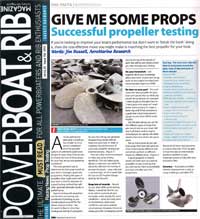 NEW Jimboat Article Announcement! - Author Jim Russell writes in POWERBOAT & RIB magazine!
NEW Jimboat Article Announcement! - Author Jim Russell writes in POWERBOAT & RIB magazine!
Jimboat outlines secrets for 'Successful Propeller Testing for Performance'
Jimboat details the speed secrets of 'Vee pad design', vee hull design and performance powerboat design
Jimboat explains 'Gearcase & Propeller BlowOut' (RIB magazine April 2011 issue)
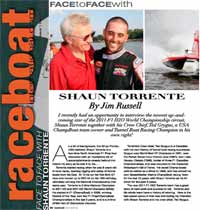 Jimboat
explains 'Chine Walking' (RIB magazine Dec 2010 issue)
Jimboat
explains 'Chine Walking' (RIB magazine Dec 2010 issue)
Jimboat explains 'How Trim Angle and engine height affects performance' (RIB magazine Jan 2011 issue)
Jimboat interviews in RaceBoat International magazine, the newest up-and-coming star of F1 H20 World Championship circuit, Shaun Torrente
together with his Crew Chief Ted Gryguc.
[Jimboat writes Feature articles in PowerBoat & RIB magazine, HotBoat, Family&Performance Boating,
Performance Powerboat, RIB magazine, World of Powerboats, RaceBoat International, SEA Yachting, Extreme Boats magazines].
-
Tunnel
Vision - 'How Do Tunnel Boats Fly?' - HB Nov/Dec 2008
- 'Why
Do Boats Create Rooster Tails?' -
HB-August 2008
- 'What
a Blow Out!' - "Gearcase & Propeller Blowout- Why it Happens & How to Fix it" -
HB-June 2008
-
'Walk on the
Wild Side' - "Chine Walk - Why it happens & How to Fix it" - HB-Jan
2008
- 'Hump
Zone' - "Why does your Boat Porpoise?" - HB-April 2007
-
'The Bottom Line'-"Why does a
Pad make a Vee Hull faster?" -
F&PB-Sept 2005
- "10
Smokin' Speed Secrets Revealed..." -
HB-Feb2005
-
"Winterizing your Performance Outboard" - F&PB-Jan2005
-
"What a Drag" - 'Trim Angle & Engine Height Can Reduce Drag and
Increase Speed' - HB-Sept2004
-
"10 Safety Tips" - 'Ten Safety Ideas for High Performance Go-Fast
Boats' - HB-Aug2004
- "Flight
Path" - 'Where does Lift Come From?' - HB-April2004
- "Rocket
Science" - 'How To Increase Your Hull's Design Speed With Aerodynamics' -
World of Powerboats-Winter2004
-
"Tunnel
Vision" - 'What Factors Influence Tunnel Hull Performance' - Extreme
Boats-April2003
- "Step-by-Step"
-
'Step
Design in Powerboats' - TBPNews #88, October 2005
******************* TBPNews
*******************
[return to top]
See you next time!
/Jimboat
>>>>>>>>>>>>>>>>>>>>>
Let us know ideas you have, requests for articles, questions or comments on TBPNews. Send
comments to TBPNews@aeromarineresearch.com
>>>>>>>>>>>>>>>>>>>>>>>>>>>>>>>>>>>>>>>>>>>>>>>>>
 Get your full, illustrated,
13th
edition copy of the world acclaimed "Secrets
of Tunnel Boat Design" book;
Get your full, illustrated,
13th
edition copy of the world acclaimed "Secrets
of Tunnel Boat Design" book;
"History
of Tunnel Boat Design" book, "Secrets
of Propeller Design" book, the "Tunnel
Boat Design" software
for tunnel and high-performance Vee-hull design,
and "PropWorks2"
software for speed prediction and propeller
selection at the AeroMarine
Research web site: http://www.aeromarineresearch.com